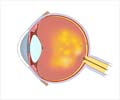Key mediators of cytochrome P450 (CYP450) enzyme pathway may prevent abnormal vessel growth and blindness in age related macular degeneration.
Highlights:
- Age-related macular degeneration is a chronic progressive condition and an important cause of blindness in the elderly characterized by abnormal new vessel growth (angiogenesis)
- Key compounds of the major cytochrome P-450 pathway are shown to check abnormal new vessel growth and prevent blindness in current study
Age-related macular degeneration affects nearly 11 million Americans and nearly 200 million persons globally with the figures expected to double by 2020. The risk of developing AMD is nearly 30 percent after 75 years of age.
AMD has been the focus of several research projects but the role of immune cells in the regulation of angiogenesis in AMD and other disorders has largely been ignored in earlier studies.
The current team embarked on this study to determine the possible role of immune cells in angiogenesis and to look for newer and possibly safer and more cost-effective therapeutic options in managing AMD.
Role Of Immune Cells In Angiogenesis In AMD – The Study
- Key compounds of the cytochrome-P450, a major enzyme pathway may influence angiogenesis and control movement of inflammatory cells to the affected area.
- Specifically, the team identified two key bioactive lipid mediators generated from the CYP pathway namely 17,18-epoxyeicosatetraenoic acid (EEQ) and 19,20-epoxydocosapentaenoic acid (EDP).
- The above two compounds were found to protect animal models of the disease from forming abnormal new vessels (angiogenesis).
"Given the high prevalence and progressive nature of neovascular eye disease, the ability to stabilize bioactive lipids that mitigate or halt disease is of great and increasingly therapeutic significance," said corresponding author Kip Connor, Ph.D., a vision scientist at Mass. Eye and Ear and Assistant Professor of Ophthalmology at Harvard Medical School. "It is our hope that emerging technologies and future studies will expand on our work, and ultimately lead to safe, targeted, and cost-effective therapies that markedly improve visual outcomes and quality of life for patients suffering from these debilitating eye diseases."
The ω-3 long-chain polyunsaturated fatty acids are a class of dietary lipids found abundantly in the central nervous system and the retina. In general the ω-3s have anti-inflammatory properties and particularly, 17,18- epoxyeicosatetraenoic acid and 19,20- epoxydocosapentaenoic acid, metabolites of the CYP pathway were shown by liquid chromatography-tandem MS and found to protect against inflammation.
The current standard of care for persons with wet AMD is based on targeting VEGF, an agent that promotes angiogenesis. Although VEGF inhibitors reduce angiogenesis and vascular permeability, there is no disease resolution or complete vessel regression.
Studies in mouse models of wet AMD have shown that Cytochrome P-450 derived EEQ and EDP promote resolution of disease, as well as aid in vascular repair and regression.
Age Related Macular Degeneration – In Brief
AMD is a leading cause of blindness in the elderly. In the advanced stages of the disease, termed ‘wet’ or neovascular AMD, there is growth of abnormal new blood vessels on the surface of the retina (the light sensitive structure at the back of the eye responsible for vision).
The abnormal angiogenesis occurs in around 10-15 percent of AMD patients, and progresses rapidly ultimately leading to blindness.
Several treatments are available to treat AMD including angiogenesis inhibitors.
Scope Of Current Study
The current study has identified a probable immune/inflammatory mechanism of angiogenesis prevention that can be further explored in future research with potential therapeutic implications of this debilitating condition.
"Although we do not fully understand how and why AMD develops, identifying additional mechanisms that regulate abnormal blood vessel growth in the eye beyond what we currently know could open up a range of possibilities for new research and treatments for AMD," Dr. Connor said.
Reference:
- Cytochrome P450-generated metabolites derived from-3 fatty acids attenuate neovascularization - (https://www.ncbi.nlm.nih.gov/pmc/articles/PMC4084420/)
Source-Medindia













